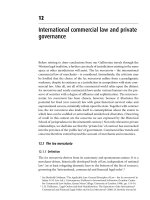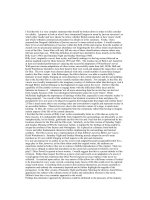commercial fishing
Bạn đang xem bản rút gọn của tài liệu. Xem và tải ngay bản đầy đủ của tài liệu tại đây (40.89 KB, 5 trang )
COMMERCIAL FISHING Commercial fishing is a worldwide enterprise
that involves the capture of marine and freshwater fish and shellfish and
their preparation for market. Fishing equipment ranges from small boats
whose nets are cast and hauled in by hand to factory ships equipped with
the most advanced technologies for finding, harvesting, and preparing
huge amounts of fish. These large catches are very costly, however, not
only in the price of their equipment and fuel, but also in the depletion of
fishery resources their use brings about. The major portion of the total fish
harvest consists of few fish species, which are divided into two primary
groups. Pelagic species - those which live in the near-surface layers of
the oceans, this include several species of herring, tuna, salmon,
anchovies, pilchard, sardines, menhaden, and mackerel. Demersal
species - fish that live in the near-bottom layers of the ocean, this
includes cod, sole, halibut, haddock, hake, and flounder. Large catches
are also made of a group of fish classed commercially as SHELLFISH -
shrimp, lobster, scallops, oysters, clams, crabs, mussels, and squid.
WHALING was once a major part of the fishing industry. Overfishing has
endangered many whale numbers, however, and the field has lessened
in importance. Almost all large pelagic and demersal fish catches
are made over or near the continental shelf, the underwater plateau
around the continents and large islands. In these waters temperatures,
water depths, and the currents that influence the amounts of available
food create an environment that is highly favourable to the existence of
large schools of fish. The animals living in and on the bottom of the
continental shelf serve as additional food sources for demersal fish. Also,
most species spawn on continental shelves, and the main nursery
grounds of many species are also in coastal regions. The main fishing
grounds are located on the wider continental shelves of the mid and high
latitudes. The single most important area is the North Pacific, where as
much as one-quarter of the world's fish catch is taken.THE
DEVELOPMENT OF THE FISHING INDUSTRYPrehistoric people were
hunters and food collectors, and they found much of their food in lakes,
rivers, and shallow coastal ocean waters. Shellfish were the most
accessible food , and the large shell heaps found around the first fishing
technique, the use of bare hands.During 10,000-6000 BC, certain
cultures that depended almost entirely on a diet of fish developed
primitive fishing technologies. The Scandinavian Maglemosian culture
used stone-pointed fishing spears, antler and bone harpoons and
fishhooks, and lines and nets woven of bark fiber. Improved equipment
increased the size of catches, and preservation techniques were
developed for drying, smoking, salting, and pickling fish. As larger boats
were built, fishing craft adventured farther into the oceans, and sea
fishing developed into a well-defined business, with settlements whose
main occupation was catching fish. Early ocean fisheries were
confined to the coastal regions of settled areas and to the Mediterranean
Sea, which had been the traditional fishing grounds for large numbers of
fish species, especially tuna. Slowly, the rich fishing regions of the
Atlantic Ocean and the North and Baltic seas began to be exploited. The
opening of these new fishing grounds had a significant influence on the
spread of trade during the Middle Ages and on the establishment of new
trade routes - for example, the herring fisheries in the southern Baltic and
North seas that helped to establish the HANSEATIC LEAGUE. The
opening of the fishing areas around Nova Scotia and Newfoundland had
a serious effect on European history. First fished by the French in the
early 1500s, by the beginning of the 17th century the North Atlantic
fisheries had become the main source of New World wealth for
England.PRINCIPAL FISHERIES The most important world fisheries are
located in waters less than 400 m in depth. Major fishing grounds are in
the North Atlantic including the GRAND BANKS and the Georges Banks
off the New England coast, the North Sea, the waters over the continental
shelves of Iceland and Norway, and the Barents Sea; in the North Pacific,
specifically the Bering Sea, the Gulf of Alaska, and the coastal areas
around Japan; and off the coasts of China and Malaysia. Other important
fishing grounds are found off the coasts of the southeastern United
States, Chile, Peru, Argentina, and the Falkland Islands, and off the
coasts of Namibia and South Africa. More than one-half of the marine
fish catch in the United States is taken in the Northeast Pacific and in
Alaskan coastal waters. In 1993 the total of all the Atlantic fisheries given
slightly more than 18 percent, with the Gulf of Mexico fishery adding
another 16 percent. Pollock, shrimp, sockeye salmon, and snow crab are
the most valuable catches - and these, with the exception of shrimp, are
all Northeast Pacific fish. Haddock landings off the New England coast
decreased in the 1980s because of overfishing. The cod fishery in the
Northeast Atlantic collapsed in the early 1990s for the same reason.
The profitable king crab fishery in the Bering Sea broke down in
the 1980s, and much of the crab fleet was changed to trawlers, which
yielded higher catches of Pacific cod and pollock in joint venture fisheries
with foreign processors, who were mainly Japanese and Russian. The
local fisheries of the African coast, and many of those found elsewhere in
the tropics, remain undeveloped. The main limiting factors are: first, the
narrowness of the continental shelf, which doesn't allow the numbers of
demersal fish, and the existence of a straight coastline that doesn't offer
many possibilities for good harbors; second, the high temperatures,
which affect the keeping quality of the fish catch; and third, limited access
to the interior, making marketing difficult. Fish landings from these areas
are usually dried, smoked, or salted immediately.FISHING
TECHNOLOGIES In most modern, commercial fishing fleets the most
common fishing vessel is the trawler, equipped with a diesel engine and
outfitted with a variety of equipment for fish finding and capturing. Factory
ships are huge, operated by crews of 500 to 650 and accompanied by
their own fleets of smaller ships called catcher boats. Some factory ships
can remain at sea for months at a time and can process and store huge
amounts of catch. Nations engaged in large-scale, distant-water fishing
operate factory ships. Some of these nations have invested heavily in
many of the factory ships owned by U.S. firms. Coastal fleets commonly
use smaller vessels that deliver their catch to processing plants on shore.
Sophisticated electronic equipment, such as sonar, is used to
detect the presence of fish schools and to verify water depths and the
roughness on the ocean bottom. Airplanes and helicopters scout
scattered schools of pelagic fish. Fish Harvesting The standard
methods of catching fish involve either nets, hooked lines, or traps.
Pelagic fish are most often harvested using purse seine nets, which are
set in a wide circle around the school of fish and then closed and drawn
up. Straight drift or gill nets - whose mesh is just large enough to allow
the heads of fish to pass through while trapping them at their gills - are
used to catch salmon, tuna, cod, and other fish. Demersal fish may be
caught in otter trawl nets pulled along the ocean bottom or netted with
beam trawls that are used in more shallow waters, mainly for shrimp.
In halibut fishing, hooked groundlines, called long lines, may reach
lengths of many miles, with baited hooks attached at intervals of 6 to 9 m.
Floating long lines are used primarily in tuna and salmon fishing, and so
are trolling lines, shorter lines towed behind a moving boat. Lights may be
lowered into fresh waters to attract fish, which are then sucked up into the
ship by vacuum pumps. Beginning in the early 1980s, Japanese,
Taiwanese, and South Korean fishing fleets began to use a new fishing
technique to make large-scale squid catches in the North Pacific. Huge,
15m deep drift nets made of unbreakable nylon, each stretching 90 m,
were lowered off the boats each evening. Together, the nets from a single
boat formed a great wall just under the surface of the ocean. The nets
drifted all night, catching any sea creatures that happened to swim into
their meshes - not only the squid, but amounts of other fish and ocean
mammals such as dolphins and seals. Drift-net assemblies began to be
used to make catches of other commercial fish in addition to squid. The
accidental catch, called "by-catch" in the trade, was thrown away.
Large-scale drift-net fishing declined after a UN resolution that went into
effect in 1993. Fish Processing Fishing vessels that make their catches
close to port store fish in crushed ice or in refrigerated sea water. Large
fishing vessels on long trips are equipped to keep their catch edible by
storing it in refrigerated facilities or by quick-freezing it. A fully equipped
factory ship will also have machinery on board for fish filleting and
freezing or canning. Fish fillets are frozen at sea into large blocks
weighing up to 45 kg, these are later reprocessed on shore into individual
portions. Some ships may also have facilities for drying and grinding fish
into fish meal.MAJOR FISHING COUNTRIES By the early 1990s, China
had emerged as the nation with the largest fish catches, totalling 16.5
million US tons in 1992. The Chinese catch is largely from fish farming.
Japan is second, with about 9.4 million US tons. Peru is next, with a catch
of 7.5 million US tons. Chile, Russia, and the United States follow, in that
order. India, with a catch of 4.6 million US tons, is the seventh-largest
fishing nation. The Pacific countries of Indonesia, Thailand, and South
Korea complete the list of the ten main fishing nations. Britain, once a
major fishing country, is now only a minor player, having caught only
895,000 US tons in 1992.OVER-FISHED FISHERIES In 1948 the total
world fish catch was about 19 million metric tons. The total catch rose to
over 60 million metric tons by 1970, almost 77 million metric tons in 1972,
and in 1989 - a record year - over 110.2 million US tons. The 1992 total
was 108 million US tons. Despite the huge size of total world catches,
fisheries scientists believe that the sustainable limits to the landings of
many important commercial species of marine fish were reached long
ago. Decreasing catches of valuable fish, such as cod and haddock, were
payed for by capturing less desirable species that would have been
thrown out in the past - pollock, pilchard, whiting. In 1994 the United
Nations Food and Agricultural Organization (FAO) announced that 13 of
the world's 17 major ocean fisheries are overfished. Overfishing, the
harvesting of a species to a point where it can't reproduce itself in serious
numbers, is in large part responsible for the decline of cod, haddock,
halibut, herring, several species of tuna, and whale. Not enough of these
fish remain in the seas to maintain spawning stocks; the fishing industry
has been consuming its capital. Technology is one reason for the huge
increase in fish landings since the 1960s. Catches were so rich that
private industry and governments both poured money into higher quality
fishing fleets. Since the 1980s, for example, the European Union
quadrupled its support for fishing, subsidizing the building of new boats
and arranging for member countries to exploit fishing grounds in other
members' jurisdictions. Since 1975, the number of trawlers on the high
seas has increased by 30 percent, and the major fishing nations now
suffer from overcapacity: the European Union could land its present
catches with only half its present fleet. In addition to overfishing, other
factors play a part in the diminishing stocks of commercial fish species.
Some are beyond human control. Most are traceable to human activity.
For example, developing human populations along the world's coasts
have added to the pollution of inland rivers and streams; estuaries and
lagoons that previously sheltered and fed juvenile fish have been filled in
and developed. Almost three-quarters of the species in the US fisheries
must live in estuaries at some stage in their growth. By-catch, the
netting and killing of unwanted fish, is another factor in the shrinkage of
fish stocks. The dolphin and porpoise kill in tuna fishing became well
known to canned-tunafish buyers in the 1980s, and the methods in which
purse seine nets are used in the tuna fisheries were changed as a result.
However, in the US shrimp fishery alone, an estimated 172,000 US tons
of juvenile fish are thrown out each year, contributing to a noticeable
decreases in the populations of snappers and groupers in the Gulf of
Mexico. The estimated by-catch in Alaskan fisheries amounts to over
one-half million US tons a year. Worldwide, as much as 30 percent of the
fish caught may be wasted as by-catch.FISHERIES MANAGEMENT
As early as the 1890s it was acknowledged that fishery resources
are limited and that they must be managed through international
agreements. In 1902 the International Council for Exploration of the Sea
(ICES) was formed by the major European fishing countries. The
founding of ICES led to many conventions for the regulation of fisheries
by quotas and by mesh size of nets, in order to obtain "maximum
sustainable yields" - the highest yields consistent with the maintenance of
fish stocks. Until recent years, such conventions were effective in the
Northeast Atlantic, although they did not operate as well in other regions.
The extension of national jurisdictions over fisheries resources to a
200-naut-mi (370-km/230-mi) zone, beginning in the 1970s, further limited
the effectiveness of many international conventions. In the United
States the Magnuson Fisheries Conservation and Management Act of
1976 placed all marine resources from three to 200 naut mi offshore
under US jurisdiction. Management is effected through eight regional
fisheries councils whose members come mainly from the industry. Each
council has the power to set quotas for the commercial fish species living
within its jurisdiction in order "to achieve optimum yield from each fishery
on a continuing basis," and to prepare recovery plans when they have
decided that overfishing is depleting stocks. In addition, the councils have
granted permits to foreign countries to harvest specified quantities of
certain fish species in return for a fee. Countries that have fished under
US license included Japan, South Korea, the former USSR, and Poland.
In their desire to maintain the prosperity of the fleets within their regions,
however, the councils have not been harsh in their recognition of
depleted stocks, the quotas they set, or their preparations for stock
recoveries. In 1994, however, the New England Fisheries Management
Council began a process that will lead to closing commercial fishing in the
Georges Bank for a number of years. Fishing in international waters
has also proved difficult to control. While it is believed, for example, that
most nations have obeyed the UN moratorium on drift-net fishing,
monitoring compliance remains an unsolved problem. The US Navy's
Sound Surveillance System, a 48,000-km network of undersea cable, is
capable of tracking drift-net operations, but budget considerations may
eventually force the sound surveillance system shutdown.









